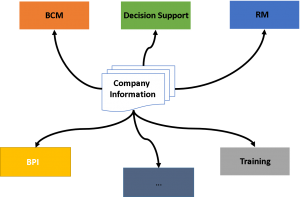Businesses big and small face one daunting challenge. As the business grows and matures, processes become complex and tacit. While the business operates successfully, it gradually become people dependent. Sometimes, matters get so complicated that businesses are often unaware what is really driving their profitability. They are unaware of which processes are critical to the success of their business.
Problem
Having performed engagements in domains like Business Continuity Management (BCM), Business Process Improvement (BPI) and Risk Management (RM), one of the most frustrating things we came across was the lack of documentation of the business processes. To complicate matters further, most of the tacit knowledge resided in the heads of senior management who just did not have time to spare for such initiatives. They were just too busy in operational matters.
This brings us to the crux of the issue that this post seeks to address.
Many organizational initiatives like BCM get delayed or fail due to non-availability of a central repository of business information. Every time a new business initiative is taken, it becomes imperative to first understand the business. Sometimes, multiple concurrent initiatives end up gathering the same information. This leads to an enormous loss of time and money, not to mention the frustration caused to senior management who have to keep repeating the same information to different consultants.
Proposed Solution
There is a need for organizations to understand and document their business, not as part of silo-ed, disparate initiatives like BCM and BPI but as a separate stand alone initiative. This initiative should not be mistaken for Knowledge Management which is more of an overarching initiative. This focused initiative would ideally capture the information that keeps the business ticking and would typically include the following:
> Business Process Documentation
> Financial metrics
> Management details
> Index of Intellectual Property residing in each department
> Indication whether the Business Process is a core process or supporting process
Attention should also be paid to how this information is stored so that it is easily and securely accessible. Solutions like Confluence has been used by us in the past that enables quick documentation and inter-process linkages. This greatly eases secure distribution of information to relevant parties.
Benefits and risks
As is evident from the preceding sections, the benefits of such an approach are significant:
> It makes the organization “people independent” to some extent
> It saves money and time spent in repetitive “Understand the organization” phases of each initiative
> It helps organizations to identify areas of improvement which are sometimes so obvious but come to the fore only when one sees the big picture
> Senior management is spared of the frustration of repeat requests for information
> On-boarding new employees becomes a simpler task and again improves productivity
The main risk that arises out of the above proposed approach is possibility of loss of confidentiality of business information. Due to aggregation of all business information in one place, there is always a likelihood of insiders or hackers trying to get to the information. However, with adequate safeguards, it is possible to protect this information by implementing adequate access controls.
(Confidis is a company that works at the intersection of business and technology. Confidis has helped non-tech organizations to leverage technology and tech companies with business intelligence.)

